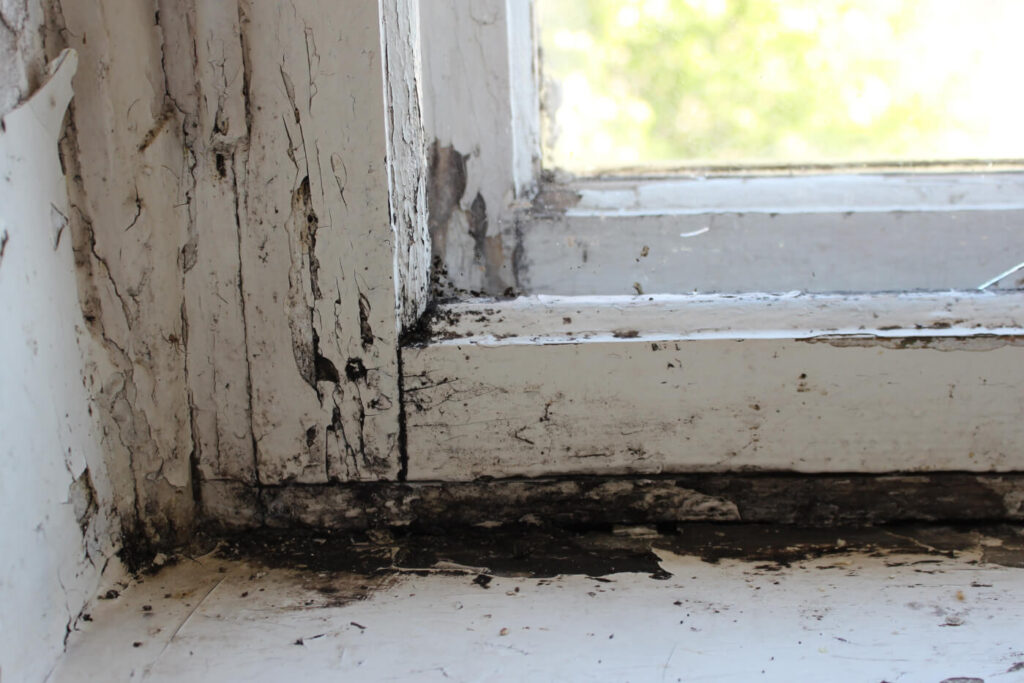
Black mould around windows not only looks unsightly in your home but can cause serious health problems too.
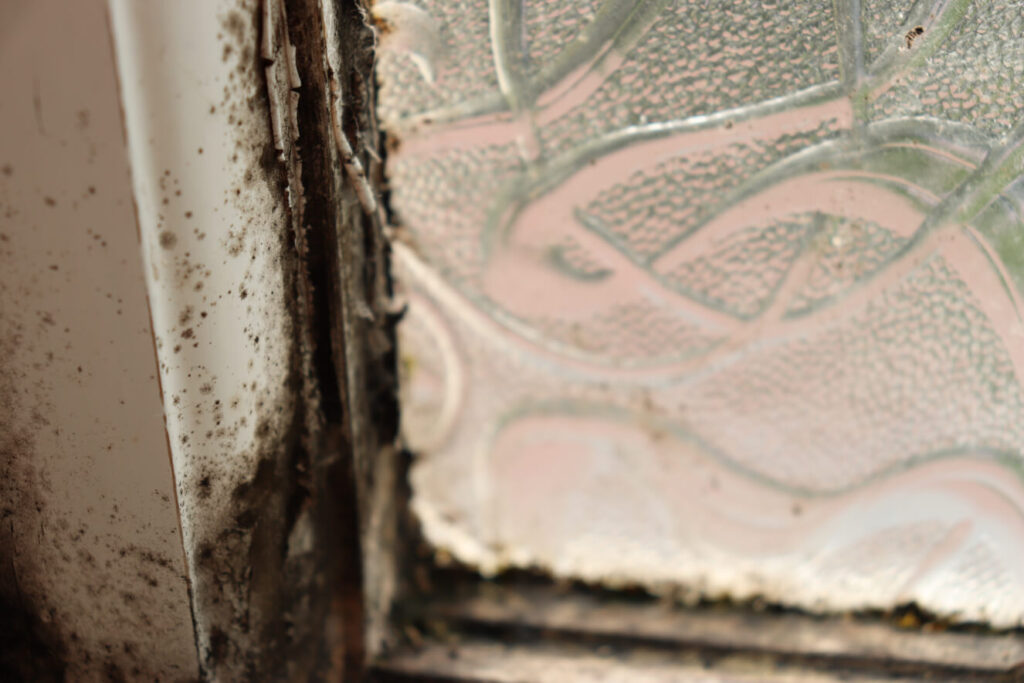
Mould growth can affect both wooden windows as well as uPVC. The windows can suffer damage due to mould over time. Surrounding decorations may be impacted as well if the mould spreads into the room.
Plus, it’s awful for you, affecting the air quality you breathe and potentially leading to serious illnesses and diseases.
Washing away the mould will not stop it from coming back.
What causes black mould on windows?
Black mould forms around windows and on window sills where there are excessive levels of moisture in the air. There can be several things that cause this.
Some of the most common are:
- Leaking window frames which allow rainwater in
- Poor roof repair, which causes penetrating dampness around windows and mould to develop
- Inadequate or inefficient heating, so the air in the house is too cold
- Leaking pipes
- Taps, shower fittings or baths
- Rising damp
- Condensation
Black mould requires constant moisture to thrive. If left unregulated can spread from around mouldy windows and across paintwork or wallpaper, invading the interior decoration in your home, which can prove costly to restore.
Bathroom and kitchen windows are the most popular for mould growth. These are generally the two environments within any home which have the most moisture-laden air and produce the greatest amounts of condensation.
Is black mould around windows dangerous?
Black mould has a technical name – ‘Stachybotrys Chartarum’ – and is known to impact air quality and cause problems with breathing.
This can lead to long-term damage to respiratory health if the spores are inhaled and the mould is not treated.
Is black mould around windows dangerous? It can be particularly dangerous for household occupants who already suffer from conditions like asthma.
Black mould releases spores known as mycotoxins which are like invisible dust. Inhaling the spores can harm airways and lungs and can also have adverse effects on the skin and nervous system.
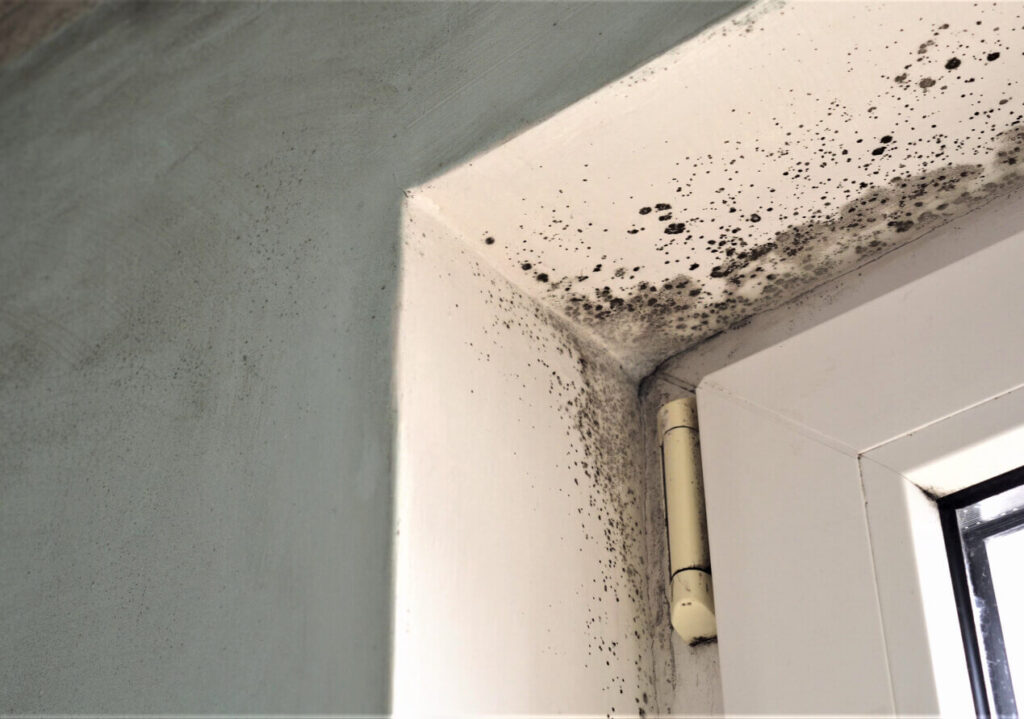
Most people only perceive mould to be dangerous if you touch it. However, the mould spores create an invisible powder of dust on the window’s surface and in the air you breathe.
Mould is not just about what you can see, but what you cannot.
Babies and the elderly are particularly vulnerable to these invisible and dangerous invaders as well as those with pre-existing respiratory conditions.
Managing condensation in the home
Mould loves moisture, and condensation is a big problem for many households.
Condensation is caused by too much moisture in the home. It is created when warm air hits the cold glass. This happens particularly during the winter months when rooms are at their warmest and the glass is at its coldest.
This is often a problem with old-fashioned windows. Rather ironically, it is exacerbated by modern, sealed, draught-free homes, which are kept very warm and allow less air circulation. These homes often have poor ventilation.
Old houses, which tend to be cold and less energy efficient with more draughts, will promote better air movement and often suffer fewer condensation problems around windows.
Four ways to manage condensation
Wiping down the glass with an absorbent cloth or using a window vacuum can eliminate condensation in an affected room. However, this is a daily chore and does not address the root cause of the problem.
Fortunately, there are several ways to manage condensation if this is the cause of black mould growth around your windows or on the window sills.
Use dehumidifiers in the worst affected rooms.
Dehumidifiers remove excess moisture from the air, reducing humidity levels in rooms prone to condensation, such as bathrooms and kitchens. This helps prevent condensation on windows, protecting wooden frames and sills.

Install extractor fans in the kitchen and the bathroom.
Extractor fans ventilate areas with high moisture production, like kitchens and bathrooms. They quickly remove moist air generated by cooking and showering, reducing condensation on windows and other surfaces.
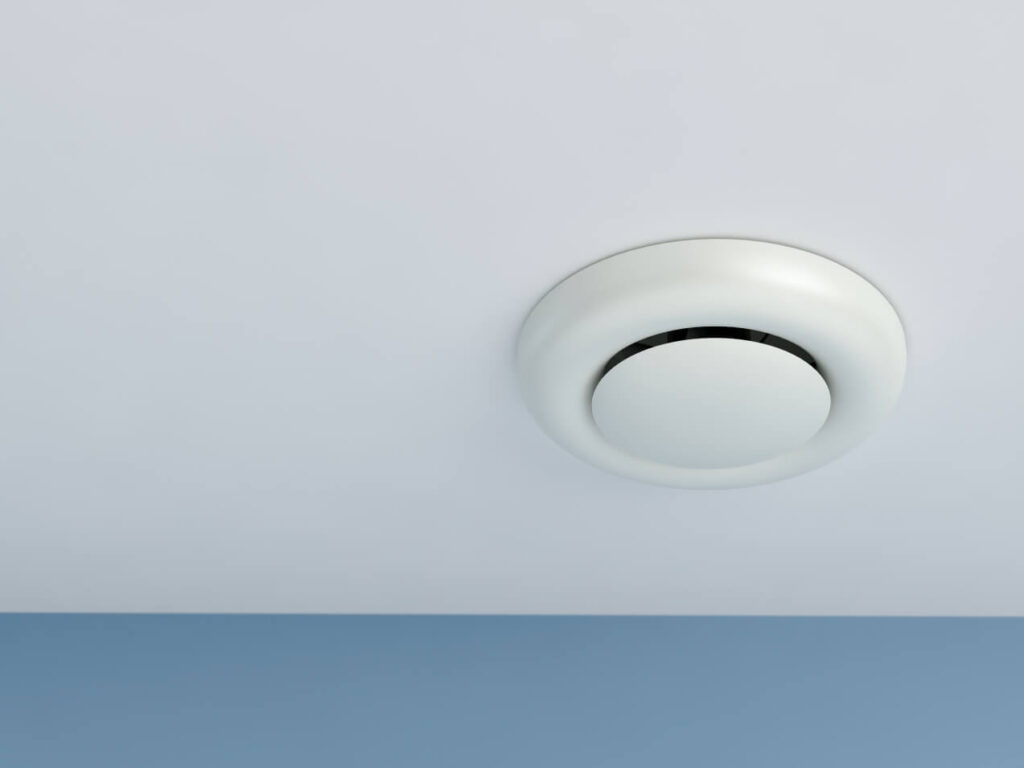
If you have a lot of house plants, then consider cutting them down in certain locations as they release moisture into the air.

Increase ventilation and air in your home to help dry moisture in the atmosphere.
Proper ventilation disperses moisture-laden air, reducing condensation.
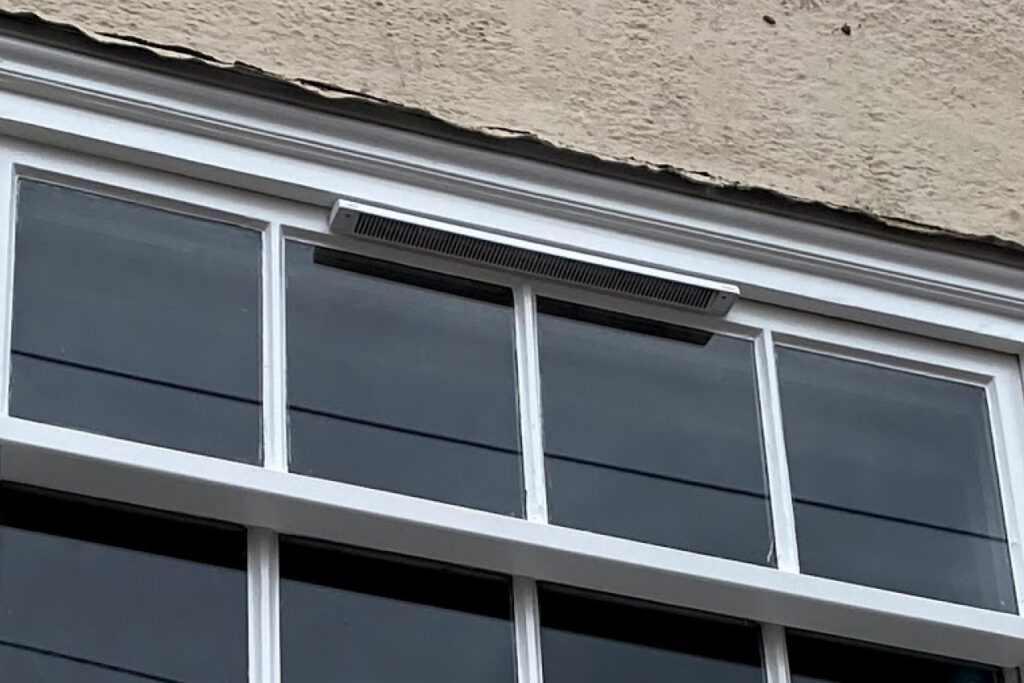
Bathrooms and kitchens are the rooms most commonly affected by condensation problems. Bedrooms can also be quite moisture-laden due to the warm air generated by occupants while they sleep, leading to mould around windows in the bedroom. It’s not unusual for bedroom windows to be running with water first thing on a cold winter morning.
A more long-term solution is to upgrade your windows if they are single-glazing or old double-glazed units.
New glazing products, such as Vacuum double glazing, offer a 0.7 U-Value and 8 mm double glazing thickness.
This provides premium thermal efficiency. It also helps manage condensation and inhibit mould growth around the windows.
This helps protect both your health and home interiors.
Keeping your home environment moisture-free
Dehumidifiers reduce or eliminate moisture in the air. This can help protect wooden window frames and sills from condensation during the winter months.
The art is to make your environment unattractive to mould growth around windows by keeping the air as dry as possible and ensuring plenty of airflows.
Exhaust fans can be fitted in kitchens and bathrooms to help remove the steam associated with bathing and cooking. They also help with ventilation in warm rooms, which can be particularly prone to condensation.
When the weather is dry (which is not very often in a British winter), use natural ventilation by opening windows for around half an hour daily to help promote airflow.
Wooden windows versus uPVC in the war on mould
Some types of mould will feed on the wood in the frame and sill of wooden windows. Wood loves moisture, so more work is needed if you want to keep the growth of mould and mould spores at bay.
However, it can be mould around the window seal on uPVC windows too, although it finds it harder to damage the actual plastic frames and sills.
Removing black mould from window frames, window sills and around windows
Black mould around windows and on the windows themselves, including the window frame and glass, must be removed.
However, if you don’t also remove the cause at the same time, then the mould will keep coming back.
The NHS recommends that householders should only remove mould patches if the area around or on the windows is smaller than one metre squared.
Anything larger should be removed by a professional cleaning company, due to the dangers posed by the spores and the dust.
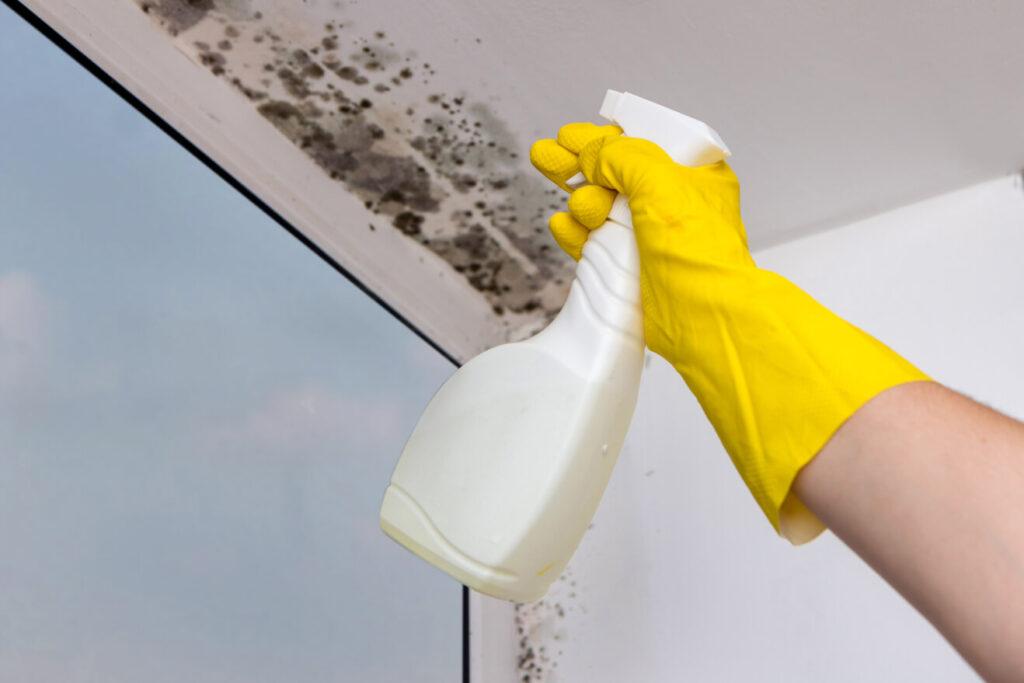
If you are washing or cleaning mould around the windows, always wear protective clothing, which should include:
- Goggles
- Rubber gloves
- A mask which covers your mouth and nose to prevent inhalation of the mould spores
Breathing and touching the mould around your windows
Breathing in spores or touching the mould around your windows can be dangerous. You may also be using solutions like bleach, which can damage the skin and should not be inhaled. Windows can be open for ventilation and fresh air.
Doors should stay closed to prevent the spread of any spores, which, when they are dry, can turn to dust and be carried through the air.
Remove the mould
Fill a bucket with hot water and some washing-up liquid. Using a clean cloth or rag, dip the material into the warm, soapy water.
Wipe away the mould from the surface – resist the temptation to wash the area, as this will just spread the mould growth around.
Rinse the rag in soapy water and repeat the process until all the mould has gone from the window. Use a second dry cloth to wipe excess moisture from the now-clean window.
Dispose of both rags, do not re-use them, as you risk introducing mould into other areas in your home.
Proprietary, branded mould cleaners are available from your local supermarket or DIY store. Still, many people dislike using strong chemicals because of the impact on both their immediate home environment and the environment at large. Warm, soapy water or household bleach will do the job just as well.

A good quality bleach will kill all types of mould. Mix one part of bleach with four parts of warm water, and either uses a plastic spray bottle or a cloth to apply the solution and wipe the mould away.
Bleach can damage colours on painted window frames and sills. So it may not be an option for every window – it can also discolour white uPVC units, turning them yellow.
Always use rubber gloves when handling a bleach solution.
Clothes, soft furnishings or textiles like cushions and throws in the vicinity of the window should be professionally cleaned or thrown away.
Looking after wooden windows to prevent mould growth in the first place
Wooden windows can be more vulnerable to mould growth if they are not kept in good repair and that’s because the window frame and sill can attract and retain moisture.
Wooden windows need to be kept in a regimen of care and maintenance. So the windows are protected from cracking and splitting, looking good and remaining watertight, keeping your home dry and damp-free.
Windows should be inspected at least annually for signs of rot and water penetration. Never ignore the telltale signs of soft areas. Rubbing down, treating the wood and repainting it will help keep moisture at bay, and any early cracks or splits can be filled.
Rotten sections of the window should be cut away and replaced with long-lasting, rot-resistant timber such as Accoya.
Tips for Maintaining Wooden Windows
- Inspect your wooden windows at least once a year for signs of rot, cracks, or water penetration. Early detection of issues can prevent extensive damage and mould growth.
- Regularly repaint or stain your wooden window frames and sills. This adds a protective layer against moisture, preventing it from seeping into the wood. Choose high-quality exterior paints and stains for the best protection.
- Use a high-quality wood sealant to fill any gaps or cracks in the window frames and sills. This prevents water from entering the wood and causing rot or mould growth.
- Ensure your home is well-ventilated to reduce indoor humidity levels. Proper ventilation helps prevent condensation on wooden windows, which can lead to mould growth.
- Keep your wooden windows clean by regularly wiping them down with a damp cloth. Remove any dirt, dust, or debris that can hold moisture against the wood.
- Apply wood preservatives to your window frames to protect them from fungi and insect damage. These treatments penetrate the wood and provide long-lasting protection.
- If you find any soft or rotten sections in your wooden windows, repair them immediately. Cut away the damaged wood and replace it with rot-resistant timber such as Accoya.
Tips To Stop Mould Around Windows
Preventing mould around windows is essential for maintaining a healthy and aesthetically pleasing home environment. Here are some expert tips to help you keep mould at bay.
Improve Ventilation
Ensure that your home has adequate ventilation. Use exhaust fans in bathrooms and kitchens to remove excess moisture. Open windows for at least 30 minutes daily to promote airflow and reduce humidity levels.
Use Dehumidifiers
Dehumidifiers are effective in reducing indoor moisture levels, particularly in rooms prone to condensation, such as bathrooms and kitchens. Place them in the most affected areas to keep the air dry.
Wipe Down Windows Regularly
Condensation on windows can lead to mould growth. Wipe down windows with an absorbent cloth or a window vacuum daily to remove moisture.
Insulate Your Home
Proper insulation helps maintain a consistent indoor temperature, reducing the likelihood of condensation forming on cold window surfaces. Consider upgrading to double or triple glazing for better thermal efficiency.
Fix Leaks Promptly
Any leaks from windows, pipes, or roofs should be addressed immediately. Water ingress can provide the necessary moisture for mould to thrive.
Use Mould-Resistant Paint
Applying mould-resistant paint around window frames and sills can create a barrier against mould growth. This is especially useful in high-moisture areas like bathrooms.
What to Consider Before Cleaning Mould from Your Window?
Before you start cleaning mould from your windows, consider the following factors to ensure safety and effectiveness:
- Size of the Affected Area – if the mould-affected area is larger than one square metre, it is advisable to seek professional help. Larger areas pose a greater health risk and require specialised cleaning.
- Type of Window Material — different materials may require different cleaning methods. For instance, bleach can damage painted wood and discolour uPVC. Choose a cleaning method that is safe for your window material.
- Protective Gear — always wear protective clothing, including goggles, rubber gloves, and a mask that covers your mouth and nose. This protects you from inhaling mould spores and coming into contact with cleaning solutions.
- Ventilation — ensure proper ventilation in the cleaning area by opening windows and doors. This helps disperse mould spores and fumes from cleaning agents.
How to Prevent Mould Build Up, Growth on Windows?
Preventing mould build-up on windows involves maintaining a dry and well-ventilated environment. Regularly clean windows and surrounding areas to remove dust and dirt, which can harbour moisture and mould spores. Control indoor humidity levels by keeping them below 60% and using dehumidifiers, especially in high-moisture areas. Ensure proper drainage by making sure window frames and sills are free from water accumulation and regularly inspect and clear any blocked drainage channels. Seal windows properly to prevent water ingress by using weather stripping and sealant to close any gaps or cracks. Lastly, monitor for leaks by regularly checking windows and surrounding areas for signs of leaks or water damage, and address any issues immediately to prevent mould growth.
Should You Clean Mould on Your Windowsill by Yourself?
Cleaning mould on your windowsill by yourself can be done safely if the affected area is small and you take proper precautions. If the mould covers less than one square metre, you can clean it yourself with the right equipment and cleaning solutions. Always wear goggles, rubber gloves, and a mask to protect yourself from mould spores and cleaning chemicals. Use a mixture of bleach and water (one part bleach to four parts water) or white vinegar to clean the mould, but avoid using bleach on painted surfaces as it can cause discolouration. Dispose of cleaning cloths and rags after use to prevent spreading mould spores to other areas of your home. If you’re unsure or the mould issue is extensive, consider seeking the services of window specialists for professional cleaning and remediation.
What Should You Do If You Find Mould on Your Windows?
If you find mould on your windows, it’s essential to act quickly to prevent further growth and potential health risks.
Begin by isolating the affected area to contain the mould spores; close doors and open windows for ventilation.
Examine the extent of the mould growth. If the mould covers a large area, more than one square metre, it is best to call a professional cleaning service due to the increased health risks and the need for specialised equipment.
For smaller areas, you can clean the mould yourself.
Wear protective gear such as goggles, rubber gloves, and a mask to avoid exposure to mould spores and cleaning chemicals.
Use a safe cleaning solution like a mixture of white vinegar and water or a specialised mould cleaner. Apply the solution and gently scrub the mould off with a brush. After cleaning, dry the area thoroughly to prevent moisture from returning.
Beyond immediate cleaning, it’s crucial to address the root cause of the mould. Check for leaks or condensation issues around your windows and fix them promptly.
Ensure proper ventilation in your home, especially in areas prone to moisture like bathrooms and kitchens.
Consider using a dehumidifier to control indoor humidity levels. Regular maintenance and monitoring will help keep mould at bay and protect both your health and home environment. If mould problems persist, seeking advice from window specialists can provide a more permanent solution.
Frequently Asked Questions about black mould around windows
Are wooden windows more at risk of suffering from black mould than uPVC units?
The answer to this is probably because wooden windows don’t often fit well after a few years unless they are well maintained.
If the wood that makes up the frames and the sills, or the mould window frame, is not treated, preserved, and re-painted or stained regularly.
Rot will set in because of the inevitable impact of weathering over the years, and it will be challenging to get rid of mould around or on the window.
Soft or rotten sections on the window frame will allow moisture to penetrate. This can cause mould growth both on the window itself and the surrounding wall.
Can you remove the window mould with vinegar?
Vinegar is an effective alternative to warm, soapy water to get rid of mould and is a common household item that can kill around 80% of different mould species.
Use white vinegar, which should be decanted into a spray bottle like a plant spray.

You can spray the vinegar straight onto the mould or onto a cloth and then wipe the mould away.
Whichever method you choose. The vinegar should be left to soak into the mould for about an hour to break it up. Otherwise, it won’t be effective and will get rid of the mould.
Use a scrubbing brush and warm water to lift away the mould from the window once the vinegar has been allowed to permeate.
Wipe the surface down using warm water and a clean cloth, and then let the area dry out.
Are wooden windows more badly affected by black mould than uPVC equivalents?
The presence of mould means the presence of moisture, and wood can retain water in a way that uPVC cannot.
It is a bit of chicken and egg as once the mould is visible, the mould will hang onto any moisture and cause the wooden window frame or sill to deteriorate even further.
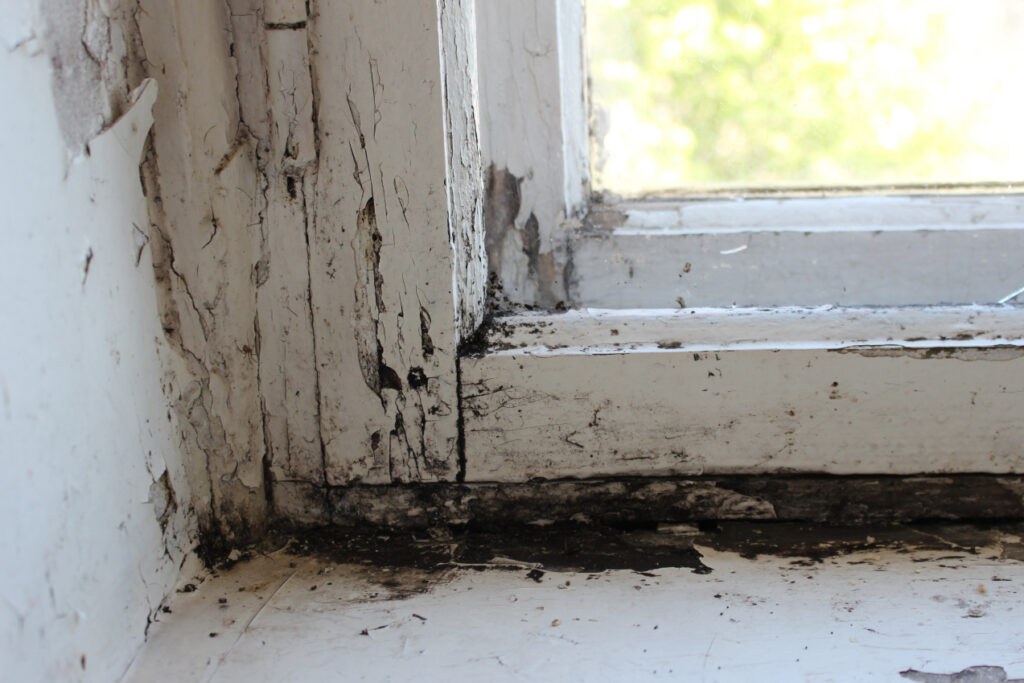
Poorly maintained wooden windows will encourage the ingress of water.
The key is to keep the window sills and frames clean and free from dust and moisture.
Act promptly whenever any splitting or rot is evident by rubbing down and re-painting or staining the wood.
Why is black mould growth always worst around the window?
The window is usually the coldest part of any room, so mould growth on the frame and sill, including mould on window frames, will appear here first.
Conclusion
The best way to manage mould growth for the health and well-being of all the occupants in the house is to make sure it cannot thrive in the first place.
The presence of black mould around windows can indicate a house that is damp.
This is especially true for rooms like the kitchen, bathroom, and bedroom, where mould above the window in the bedroom is common due to being more moisture-laden and lacking adequate air movement.
This will impact the health of all who live there.
Keeping your house free from dust and dampness is the solution to a persistent mould problem. But if you are still struggling and worried about your health, then a change of windows can be the solution.
Read more articles
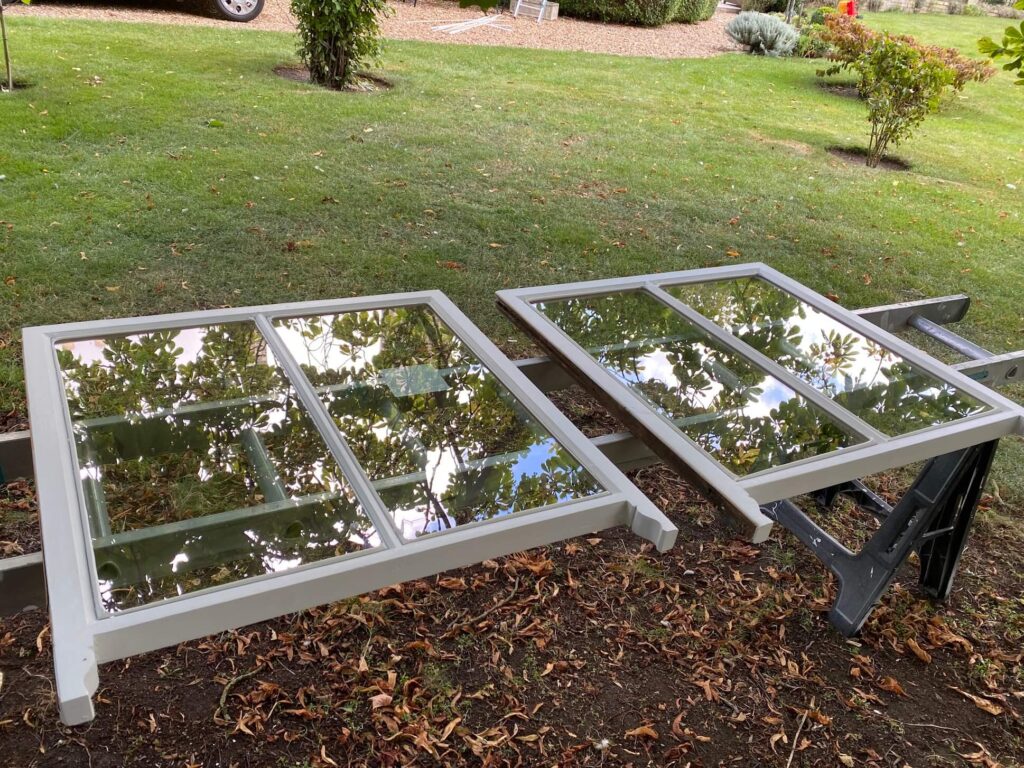
Permanent insulation for windows
Permanent insulation for windows
Leaded windows double glazing retrofitting
Leaded windows double glazing retrofitting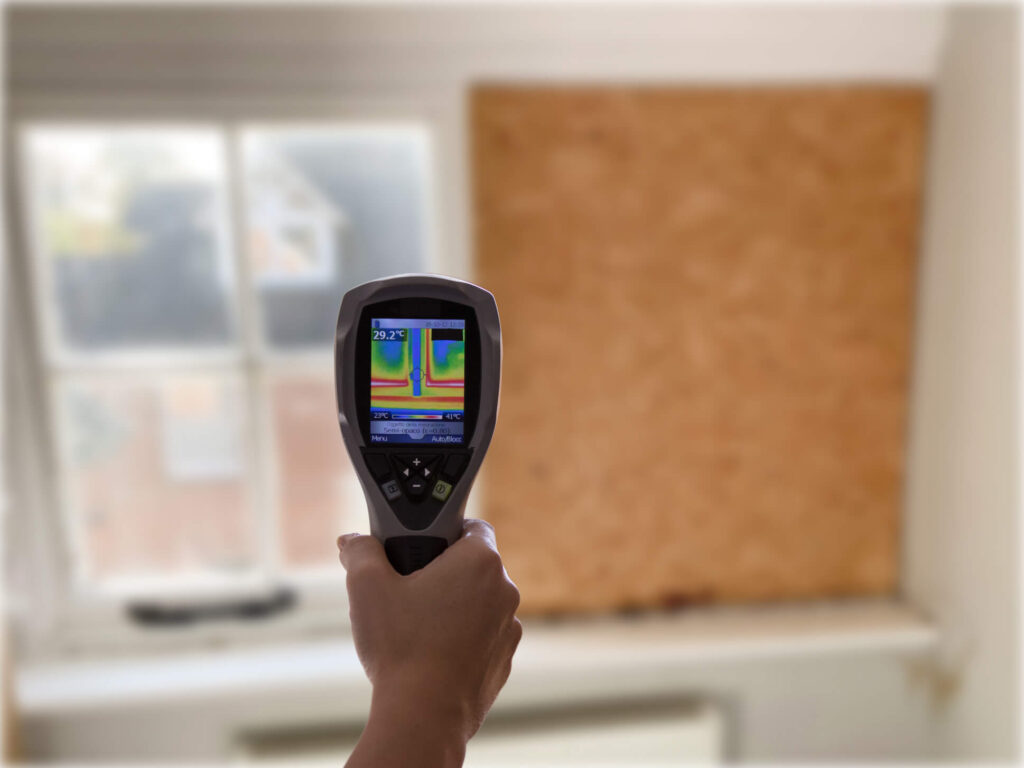
0% VAT on draught-proofing services
0% VAT on draught-proofing services
